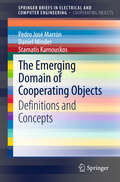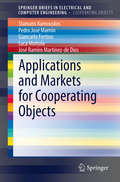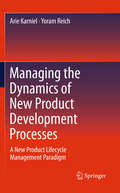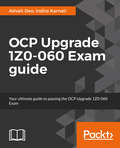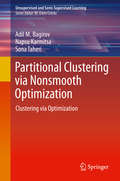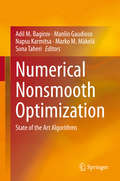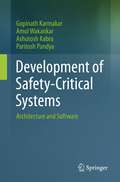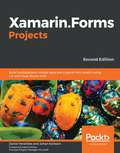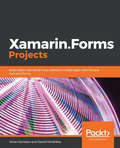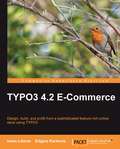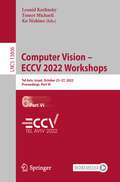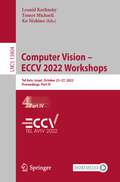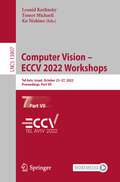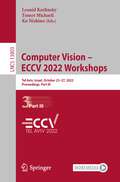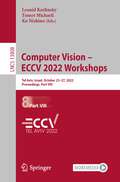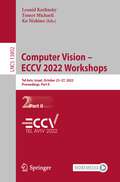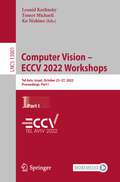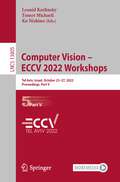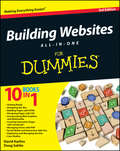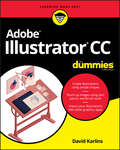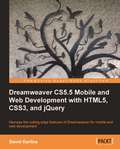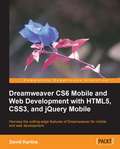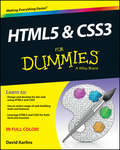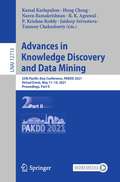- Table View
- List View
The Emerging Domain of Cooperating Objects
by Stamatis Karnouskos Daniel Minder Pedro José MarrónThis book provides a classification of current and future applications for the domain of Cooperating Objects. The book has been created with a very strong participation of the industry and taking into account current research trends and industrial roadmaps
Applications and Markets for Cooperating Objects (SpringerBriefs in Electrical and Computer Engineering)
by Stamatis Karnouskos Pedro José Marrón Luca Mottola Giancarlo Fortino José Ramiro Martínez-de DiosThis book provides an overview and an insight in cooperative objects and defines the classification of topics into the different areas. A significant number of researchers and industrial partners were contacted in order to prepare the roadmap. The book presents of the main results provided by the corresponding European project "CONET".
Managing the Dynamics of New Product Development Processes
by Arie Karniel Yoram ReichManaging the Dynamics of New-Product Development Processes merges product-based planning, process modelling, process execution, probabilistic simulations, and simulation based decision-making into one framework called the Dynamic new-Product Development Process. It provides readers with a means of improving the management of product development through enhanced methods and tools that are specifically tailored to the characteristics and challenges of such processes. It calls for a new Product Lifecycle Management paradigm of utilizing the managed product data for management of the product's development process. Within the framework, the methods used are enhanced or modified to fit the new-product development process requirements. Each specific method is exhaustively analyzed, from the basic definition of terms through a description of the state of the art of that topic and its limitations. Then, the method enhancements are illustrated by many examples, and discussed while suggesting further research directions. Finally, the enhanced methods are integrated and demonstrated by a test case. The main two methods described are the design structure matrix (DSM) and Petri nets, which are merged into a novel concept entitled DSM nets. Managing the Dynamics of New Product Development Processes provides algorithms, proofs, and practical examples that can be used for general study of the issues concerned. The main concepts presented are applicable to systems engineering and can be used by practitioners of product development processes, such as designers, product managers, and process managers, as well as developers of process management tools for systems with dynamically changing process structures.
Parallel Scientific Computing in C++ and MPI
by George Em KarniadakisNumerical algorithms, modern programming techniques, and parallel computing are often taught serially across different courses and different textbooks. The need to integrate concepts and tools usually comes only in employment or in research - after the courses are concluded - forcing the student to synthesise what is perceived to be three independent subfields into one. This book provides a seamless approach to stimulate the student simultaneously through the eyes of multiple disciplines, leading to enhanced understanding of scientific computing as a whole. The book includes both basic as well as advanced topics and places equal emphasis on the discretization of partial differential equations and on solvers. Some of the advanced topics include wavelets, high-order methods, non-symmetric systems, and parallelization of sparse systems. The material covered is suited to students from engineering, computer science, physics and mathematics.
OCP 12c Upgrade 1Z0-060 Exam Guide
by Indira Karnati Advait DeoYour ultimate guide to passing the OCP 12c Upgrade 1Z0-060 Exam About This Book * This is your one-stop solution to understanding what's new in Oracle 12c and how to bring these features to your systems in a hassle-free manner * A complete guide to clearing the OCP Upgrade 1Z0-060 Exam * Dive deep into Oracle administration and get up to date Who This Book Is For This book is for Oracle Admins who have a working knowledge of Oracle administration and now want to upgrade their knowledge to the latest version (Oracle 12c). This book is perfect for those who wish to pass the OCP Upgrade 1Z0-060 Exam. What You Will Learn * All of the new features of the Oracle 12c database that you are required to know for the OCP Upgrade Exam 1Z0-060 * New multitenant architecture introduced in Oracle 12c and how it works * Monitor complex database operations and use the new enhanced SQL tuning features to tune bad SQLs * Manage data over time using information life cycle management * Make your data more secure by implementing new enhanced auditing * Learn new security features and how to implement encryption to secure your data * Explore how backup and flashback works with new multitenant architecture * Performance management techniques that will analyze and tune your database In Detail This guide will get Oracle admins up to date with the latest developments in Oracle 12c. It includes all the necessary information that you need to implement in your existing systems. All of the information in this book has been handpicked to help you study for the Oracle 12c upgrade exam. Each chapter has been written with the objective of helping you pass this exam with ease. Content in this book is aligned with the objectives of the exam, making it really easy to follow the course content. Every example mentioned in this book has been tried and tested in actual environment. Real-world examples will help you learn about new features such as multitenant containers database architecture, managing containers, pluggable databases, database administration enhancements, database auditing, tuning, backup, and flashback enhancements. You will also learn about storage enhancements, security updates, tuning, troubleshooting, and backup enhancements. This book also covers section 2 of the exam course making this book a complete guide for passing OCP 12c upgrade exam 1Z0-060. Style and approach This book systematically covers various aspects of Oracle administration and provides the information necessary to pass the OCP Upgrade 1Z0-060 Exam Set 1 and Set 2.
Partitional Clustering via Nonsmooth Optimization: Clustering via Optimization (Unsupervised and Semi-Supervised Learning)
by Napsu Karmitsa Sona Taheri Adil M. BagirovThis book describes optimization models of clustering problems and clustering algorithms based on optimization techniques, including their implementation, evaluation, and applications. The book gives a comprehensive and detailed description of optimization approaches for solving clustering problems; the authors' emphasis on clustering algorithms is based on deterministic methods of optimization. The book also includes results on real-time clustering algorithms based on optimization techniques, addresses implementation issues of these clustering algorithms, and discusses new challenges arising from big data. The book is ideal for anyone teaching or learning clustering algorithms. It provides an accessible introduction to the field and it is well suited for practitioners already familiar with the basics of optimization.
Numerical Nonsmooth Optimization: State of the Art Algorithms
by Napsu Karmitsa Marko M. Mäkelä Manlio Gaudioso Adil M. Bagirov Sona TaheriSolving nonsmooth optimization (NSO) problems is critical in many practical applications and real-world modeling systems. The aim of this book is to survey various numerical methods for solving NSO problems and to provide an overview of the latest developments in the field. Experts from around the world share their perspectives on specific aspects of numerical NSO. The book is divided into four parts, the first of which considers general methods including subgradient, bundle and gradient sampling methods. In turn, the second focuses on methods that exploit the problem’s special structure, e.g. algorithms for nonsmooth DC programming, VU decomposition techniques, and algorithms for minimax and piecewise differentiable problems. The third part considers methods for special problems like multiobjective and mixed integer NSO, and problems involving inexact data, while the last part highlights the latest advancements in derivative-free NSO. Given its scope, the book is ideal for students attending courses on numerical nonsmooth optimization, for lecturers who teach optimization courses, and for practitioners who apply nonsmooth optimization methods in engineering, artificial intelligence, machine learning, and business. Furthermore, it can serve as a reference text for experts dealing with nonsmooth optimization.
Development of Safety-Critical Systems: Architecture and Software
by Gopinath Karmakar Amol Wakankar Ashutosh Kabra Paritosh PandyaThis book provides professionals and students with practical guidance for the development of safety-critical computer-based systems. It covers important aspects ranging from complying with standards and guidelines to the necessary software development process and tools, and also techniques pertaining to model-based application development platforms as well as qualified programmable controllers.After a general introduction to the book’s topic in chapter 1, chapter 2 discusses dependability aspects of safety systems and how architectural design at the system level helps deal with failures and yet achieves the targeted dependability attributes. Chapter 3 presents the software development process which includes verification and validation at every stage, essential to the development of software for systems performing safety functions. It also explains how the process helps in developing a safety case that can be independently verified and validated. The subsequent chapter 4 presents some important standards and guidelines, which apply to different industries and in different countries. Chapter 5 then discusses the steps towards complying with the standards at every phase of development. It offers a guided tour traversing the path of software qualification by exploring the necessary steps towards achieving the goal with the help of case studies. Chapter 6 highlights the application of formal methods for the development of safety systems software and introduces some available notations and tools which assist the process. Finally, chapter 7 presents a detailed discussion on the importance and the advantages of qualified platforms for safety systems application development, including programmable controller (PLC) and formal model-based development platforms. Each chapter includes case studies illustrating the subject matter.The book is aimed at both practitioners and students interested in the art and science of developing computer-based systems for safety-critical applications. Both audiences will get insights into the tools and techniques along with the latest developments in the design, analysis and qualification, which are constrained by the regulatory and compliance requirements mandated by the applicable guides and standards. It also addresses the needs of professionals and young graduates who specialize in the development of necessary tools and qualified platforms.
Xamarin.Forms Projects: Build multiplatform mobile apps and a game from scratch using C# and Visual Studio 2019, 2nd Edition
by Johan Karlsson Daniel Hindrikes David OrtinauLearn to build cross-platform mobile apps using the latest features in Xamarin.Forms 4 with the help of a series of projects including apps for real-time chatting, AR games, location-tracking, weather, photo galleries, and much more Key Features Develop mobile apps, AR games, and chatbots of varying complexity with the help of real-world examples Explore the important features of Xamarin.Forms 4 such as Shell, CollectionView, and CarouselView Get to grips with advanced concepts such as AR and VR and machine learning for mobile development Book Description Xamarin.Forms is a lightweight cross-platform development toolkit for building apps with a rich user interface. Improved and updated to cover the latest features of Xamarin.Forms, this second edition covers CollectionView and Shell, along with interesting concepts such as augmented reality (AR) and machine learning. Starting with an introduction to Xamarin and how it works, this book shares tips for choosing the type of development environment you should strive for when planning cross-platform mobile apps. You'll build your first Xamarin.Forms app and learn how to use Shell to implement the app architecture. The book gradually increases the level of complexity of the projects, guiding you through creating apps ranging from a location tracker and weather map to an AR game and face recognition. As you advance, the book will take you through modern mobile development frameworks such as SQLite, .NET Core Mono, ARKit, and ARCore. You'll be able to customize your apps for both Android and iOS platforms to achieve native-like performance and speed. The book is filled with engaging examples, so you can grasp essential concepts by writing code instead of reading through endless theory. By the end of this book, you'll be ready to develop your own native apps with Xamarin.Forms and its associated technologies, such as .NET Core, Visual Studio 2019, and C#. What you will learn Set up Xamarin.Forms to build native apps with code-sharing capabilities Understand the core aspects of developing a mobile app, such as its layout, UX, and rendering Use custom renderers to gain platform-specific access Discover how to create custom layouts for your apps with Xamarin.Forms Shell Use Azure SignalR to implement serverless services in your Xamarin apps Create an augmented reality (AR) game for Android and iOS using ARCore and ARKit, respectively Build and train machine learning models using CoreML, TensorFlow, and Azure Cognitive Services Who this book is for This book is for C# and .NET developers who want to learn Xamarin.Forms and get started with native Xamarin mobile application development from the ground up. Working knowledge of Visual Studio will help you to get the most out of this book.
Xamarin.Forms Projects: Build Seven Real-world Cross-platform Mobile Apps With C# And Xamarin. Forms
by Johan Karlsson Daniel HindrikesThe book is for mobile application developers who want to start building native mobile apps and use the knowledge that they already have. Working knowledge of C#, .NET and Visual Studio is required.
TYPO3 4.2 E-Commerce
by Edgars KarlsonsThis is a fast-paced tutorial focusing on creating an online store. It walks in detail through development of a sample website, illustrating each step with screenshots and explanation. The cumbersome and time-consuming task of developing and customizing a TYPO3 e-commerce site will be a smooth sail with this book. If you want to create a captivating online shop using TYPO3 and optimize your profit, this book is for you. Some knowledge of TYPO3, PHP, and TypoScript is required.
Computer Vision – ECCV 2022 Workshops: Tel Aviv, Israel, October 23–27, 2022, Proceedings, Part VI (Lecture Notes in Computer Science #13806)
by Leonid Karlinsky Tomer Michaeli Ko NishinoThe 8-volume set, comprising the LNCS books 13801 until 13809, constitutes the refereed proceedings of 38 out of the 60 workshops held at the 17th European Conference on Computer Vision, ECCV 2022. The conference took place in Tel Aviv, Israel, during October 23-27, 2022; the workshops were held hybrid or online.The 367 full papers included in this volume set were carefully reviewed and selected for inclusion in the ECCV 2022 workshop proceedings. They were organized in individual parts as follows: Part I: W01 - AI for Space; W02 - Vision for Art; W03 - Adversarial Robustness in the Real World; W04 - Autonomous Vehicle Vision Part II: W05 - Learning With Limited and Imperfect Data; W06 - Advances in Image Manipulation; Part III: W07 - Medical Computer Vision; W08 - Computer Vision for Metaverse; W09 - Self-Supervised Learning: What Is Next?; Part IV: W10 - Self-Supervised Learning for Next-Generation Industry-Level Autonomous Driving; W11 - ISIC Skin Image Analysis; W12 - Cross-Modal Human-Robot Interaction; W13 - Text in Everything; W14 - BioImage Computing; W15 - Visual Object-Oriented Learning Meets Interaction: Discovery, Representations, and Applications; W16 - AI for Creative Video Editing and Understanding; W17 - Visual Inductive Priors for Data-Efficient Deep Learning; W18 - Mobile Intelligent Photography and Imaging; Part V: W19 - People Analysis: From Face, Body and Fashion to 3D Virtual Avatars; W20 - Safe Artificial Intelligence for Automated Driving; W21 - Real-World Surveillance: Applications and Challenges; W22 - Affective Behavior Analysis In-the-Wild; Part VI: W23 - Visual Perception for Navigation in Human Environments: The JackRabbot Human Body Pose Dataset and Benchmark; W24 - Distributed Smart Cameras; W25 - Causality in Vision; W26 - In-Vehicle Sensing and Monitorization; W27 - Assistive Computer Vision and Robotics; W28 - Computational Aspects of Deep Learning; Part VII: W29 - Computer Vision for Civil and Infrastructure Engineering; W30 - AI-Enabled Medical Image Analysis: Digital Pathology and Radiology/COVID19; W31 - Compositional and Multimodal Perception; Part VIII: W32 - Uncertainty Quantification for Computer Vision; W33 - Recovering 6D Object Pose; W34 - Drawings and Abstract Imagery: Representation and Analysis; W35 - Sign Language Understanding; W36 - A Challenge for Out-of-Distribution Generalization in Computer Vision; W37 - Vision With Biased or Scarce Data; W38 - Visual Object Tracking Challenge.
Computer Vision – ECCV 2022 Workshops: Tel Aviv, Israel, October 23–27, 2022, Proceedings, Part IV (Lecture Notes in Computer Science #13804)
by Leonid Karlinsky Tomer Michaeli Ko NishinoThe 8-volume set, comprising the LNCS books 13801 until 13809, constitutes the refereed proceedings of 38 out of the 60 workshops held at the 17th European Conference on Computer Vision, ECCV 2022. The conference took place in Tel Aviv, Israel, during October 23-27, 2022; the workshops were held hybrid or online.The 367 full papers included in this volume set were carefully reviewed and selected for inclusion in the ECCV 2022 workshop proceedings. They were organized in individual parts as follows: Part I: W01 - AI for Space; W02 - Vision for Art; W03 - Adversarial Robustness in the Real World; W04 - Autonomous Vehicle Vision Part II: W05 - Learning With Limited and Imperfect Data; W06 - Advances in Image Manipulation; Part III: W07 - Medical Computer Vision; W08 - Computer Vision for Metaverse; W09 - Self-Supervised Learning: What Is Next?; Part IV: W10 - Self-Supervised Learning for Next-Generation Industry-Level Autonomous Driving; W11 - ISIC Skin Image Analysis; W12 - Cross-Modal Human-Robot Interaction; W13 - Text in Everything; W14 - BioImage Computing; W15 - Visual Object-Oriented Learning Meets Interaction: Discovery, Representations, and Applications; W16 - AI for Creative Video Editing and Understanding; W17 - Visual Inductive Priors for Data-Efficient Deep Learning; W18 - Mobile Intelligent Photography and Imaging; Part V: W19 - People Analysis: From Face, Body and Fashion to 3D Virtual Avatars; W20 - Safe Artificial Intelligence for Automated Driving; W21 - Real-World Surveillance: Applications and Challenges; W22 - Affective Behavior Analysis In-the-Wild; Part VI: W23 - Visual Perception for Navigation in Human Environments: The JackRabbot Human Body Pose Dataset and Benchmark; W24 - Distributed Smart Cameras; W25 - Causality in Vision; W26 - In-Vehicle Sensing and Monitorization; W27 - Assistive Computer Vision and Robotics; W28 - Computational Aspects of Deep Learning; Part VII: W29 - Computer Vision for Civil and Infrastructure Engineering; W30 - AI-Enabled Medical Image Analysis: Digital Pathology and Radiology/COVID19; W31 - Compositional and Multimodal Perception; Part VIII: W32 - Uncertainty Quantification for Computer Vision; W33 - Recovering 6D Object Pose; W34 - Drawings and Abstract Imagery: Representation and Analysis; W35 - Sign Language Understanding; W36 - A Challenge for Out-of-Distribution Generalization in Computer Vision; W37 - Vision With Biased or Scarce Data; W38 - Visual Object Tracking Challenge.
Computer Vision – ECCV 2022 Workshops: Tel Aviv, Israel, October 23–27, 2022, Proceedings, Part VII (Lecture Notes in Computer Science #13807)
by Leonid Karlinsky Tomer Michaeli Ko NishinoThe 8-volume set, comprising the LNCS books 13801 until 13809, constitutes the refereed proceedings of 38 out of the 60 workshops held at the 17th European Conference on Computer Vision, ECCV 2022. The conference took place in Tel Aviv, Israel, during October 23-27, 2022; the workshops were held hybrid or online.The 367 full papers included in this volume set were carefully reviewed and selected for inclusion in the ECCV 2022 workshop proceedings. They were organized in individual parts as follows: Part I: W01 - AI for Space; W02 - Vision for Art; W03 - Adversarial Robustness in the Real World; W04 - Autonomous Vehicle Vision Part II: W05 - Learning With Limited and Imperfect Data; W06 - Advances in Image Manipulation; Part III: W07 - Medical Computer Vision; W08 - Computer Vision for Metaverse; W09 - Self-Supervised Learning: What Is Next?; Part IV: W10 - Self-Supervised Learning for Next-Generation Industry-Level Autonomous Driving; W11 - ISIC Skin Image Analysis; W12 - Cross-Modal Human-Robot Interaction; W13 - Text in Everything; W14 - BioImage Computing; W15 - Visual Object-Oriented Learning Meets Interaction: Discovery, Representations, and Applications; W16 - AI for Creative Video Editing and Understanding; W17 - Visual Inductive Priors for Data-Efficient Deep Learning; W18 - Mobile Intelligent Photography and Imaging; Part V: W19 - People Analysis: From Face, Body and Fashion to 3D Virtual Avatars; W20 - Safe Artificial Intelligence for Automated Driving; W21 - Real-World Surveillance: Applications and Challenges; W22 - Affective Behavior Analysis In-the-Wild; Part VI: W23 - Visual Perception for Navigation in Human Environments: The JackRabbot Human Body Pose Dataset and Benchmark; W24 - Distributed Smart Cameras; W25 - Causality in Vision; W26 - In-Vehicle Sensing and Monitorization; W27 - Assistive Computer Vision and Robotics; W28 - Computational Aspects of Deep Learning; Part VII: W29 - Computer Vision for Civil and Infrastructure Engineering; W30 - AI-Enabled Medical Image Analysis: Digital Pathology and Radiology/COVID19; W31 - Compositional and Multimodal Perception; Part VIII: W32 - Uncertainty Quantification for Computer Vision; W33 - Recovering 6D Object Pose; W34 - Drawings and Abstract Imagery: Representation and Analysis; W35 - Sign Language Understanding; W36 - A Challenge for Out-of-Distribution Generalization in Computer Vision; W37 - Vision With Biased or Scarce Data; W38 - Visual Object Tracking Challenge.
Computer Vision – ECCV 2022 Workshops: Tel Aviv, Israel, October 23–27, 2022, Proceedings, Part III (Lecture Notes in Computer Science #13803)
by Leonid Karlinsky Tomer Michaeli Ko NishinoThe 8-volume set, comprising the LNCS books 13801 until 13809, constitutes the refereed proceedings of 38 out of the 60 workshops held at the 17th European Conference on Computer Vision, ECCV 2022. The conference took place in Tel Aviv, Israel, during October 23-27, 2022; the workshops were held hybrid or online.The 367 full papers included in this volume set were carefully reviewed and selected for inclusion in the ECCV 2022 workshop proceedings. They were organized in individual parts as follows: Part I: W01 - AI for Space; W02 - Vision for Art; W03 - Adversarial Robustness in the Real World; W04 - Autonomous Vehicle Vision Part II: W05 - Learning With Limited and Imperfect Data; W06 - Advances in Image Manipulation; Part III: W07 - Medical Computer Vision; W08 - Computer Vision for Metaverse; W09 - Self-Supervised Learning: What Is Next?; Part IV: W10 - Self-Supervised Learning for Next-Generation Industry-Level Autonomous Driving; W11 - ISIC Skin Image Analysis; W12 - Cross-Modal Human-Robot Interaction; W13 - Text in Everything; W14 - BioImage Computing; W15 - Visual Object-Oriented Learning Meets Interaction: Discovery, Representations, and Applications; W16 - AI for Creative Video Editing and Understanding; W17 - Visual Inductive Priors for Data-Efficient Deep Learning; W18 - Mobile Intelligent Photography and Imaging; Part V: W19 - People Analysis: From Face, Body and Fashion to 3D Virtual Avatars; W20 - Safe Artificial Intelligence for Automated Driving; W21 - Real-World Surveillance: Applications and Challenges; W22 - Affective Behavior Analysis In-the-Wild; Part VI: W23 - Visual Perception for Navigation in Human Environments: The JackRabbot Human Body Pose Dataset and Benchmark; W24 - Distributed Smart Cameras; W25 - Causality in Vision; W26 - In-Vehicle Sensing and Monitorization; W27 - Assistive Computer Vision and Robotics; W28 - Computational Aspects of Deep Learning; Part VII: W29 - Computer Vision for Civil and Infrastructure Engineering; W30 - AI-Enabled Medical Image Analysis: Digital Pathology and Radiology/COVID19; W31 - Compositional and Multimodal Perception; Part VIII: W32 - Uncertainty Quantification for Computer Vision; W33 - Recovering 6D Object Pose; W34 - Drawings and Abstract Imagery: Representation and Analysis; W35 - Sign Language Understanding; W36 - A Challenge for Out-of-Distribution Generalization in Computer Vision; W37 - Vision With Biased or Scarce Data; W38 - Visual Object Tracking Challenge.
Computer Vision – ECCV 2022 Workshops: Tel Aviv, Israel, October 23–27, 2022, Proceedings, Part VIII (Lecture Notes in Computer Science #13808)
by Leonid Karlinsky Tomer Michaeli Ko NishinoThe 8-volume set, comprising the LNCS books 13801 until 13809, constitutes the refereed proceedings of 38 out of the 60 workshops held at the 17th European Conference on Computer Vision, ECCV 2022. The conference took place in Tel Aviv, Israel, during October 23-27, 2022; the workshops were held hybrid or online.The 367 full papers included in this volume set were carefully reviewed and selected for inclusion in the ECCV 2022 workshop proceedings. They were organized in individual parts as follows: Part I: W01 - AI for Space; W02 - Vision for Art; W03 - Adversarial Robustness in the Real World; W04 - Autonomous Vehicle Vision Part II: W05 - Learning With Limited and Imperfect Data; W06 - Advances in Image Manipulation; Part III: W07 - Medical Computer Vision; W08 - Computer Vision for Metaverse; W09 - Self-Supervised Learning: What Is Next?; Part IV: W10 - Self-Supervised Learning for Next-Generation Industry-Level Autonomous Driving; W11 - ISIC Skin Image Analysis; W12 - Cross-Modal Human-Robot Interaction; W13 - Text in Everything; W14 - BioImage Computing; W15 - Visual Object-Oriented Learning Meets Interaction: Discovery, Representations, and Applications; W16 - AI for Creative Video Editing and Understanding; W17 - Visual Inductive Priors for Data-Efficient Deep Learning; W18 - Mobile Intelligent Photography and Imaging; Part V: W19 - People Analysis: From Face, Body and Fashion to 3D Virtual Avatars; W20 - Safe Artificial Intelligence for Automated Driving; W21 - Real-World Surveillance: Applications and Challenges; W22 - Affective Behavior Analysis In-the-Wild; Part VI: W23 - Visual Perception for Navigation in Human Environments: The JackRabbot Human Body Pose Dataset and Benchmark; W24 - Distributed Smart Cameras; W25 - Causality in Vision; W26 - In-Vehicle Sensing and Monitorization; W27 - Assistive Computer Vision and Robotics; W28 - Computational Aspects of Deep Learning; Part VII: W29 - Computer Vision for Civil and Infrastructure Engineering; W30 - AI-Enabled Medical Image Analysis: Digital Pathology and Radiology/COVID19; W31 - Compositional and Multimodal Perception; Part VIII: W32 - Uncertainty Quantification for Computer Vision; W33 - Recovering 6D Object Pose; W34 - Drawings and Abstract Imagery: Representation and Analysis; W35 - Sign Language Understanding; W36 - A Challenge for Out-of-Distribution Generalization in Computer Vision; W37 - Vision With Biased or Scarce Data; W38 - Visual Object Tracking Challenge.
Computer Vision – ECCV 2022 Workshops: Tel Aviv, Israel, October 23–27, 2022, Proceedings, Part II (Lecture Notes in Computer Science #13802)
by Leonid Karlinsky Tomer Michaeli Ko NishinoThe 8-volume set, comprising the LNCS books 13801 until 13809, constitutes the refereed proceedings of 38 out of the 60 workshops held at the 17th European Conference on Computer Vision, ECCV 2022. The conference took place in Tel Aviv, Israel, during October 23-27, 2022; the workshops were held hybrid or online.The 367 full papers included in this volume set were carefully reviewed and selected for inclusion in the ECCV 2022 workshop proceedings. They were organized in individual parts as follows: Part I: W01 - AI for Space; W02 - Vision for Art; W03 - Adversarial Robustness in the Real World; W04 - Autonomous Vehicle Vision Part II: W05 - Learning With Limited and Imperfect Data; W06 - Advances in Image Manipulation; Part III: W07 - Medical Computer Vision; W08 - Computer Vision for Metaverse; W09 - Self-Supervised Learning: What Is Next?; Part IV: W10 - Self-Supervised Learning for Next-Generation Industry-Level Autonomous Driving; W11 - ISIC Skin Image Analysis; W12 - Cross-Modal Human-Robot Interaction; W13 - Text in Everything; W14 - BioImage Computing; W15 - Visual Object-Oriented Learning Meets Interaction: Discovery, Representations, and Applications; W16 - AI for Creative Video Editing and Understanding; W17 - Visual Inductive Priors for Data-Efficient Deep Learning; W18 - Mobile Intelligent Photography and Imaging; Part V: W19 - People Analysis: From Face, Body and Fashion to 3D Virtual Avatars; W20 - Safe Artificial Intelligence for Automated Driving; W21 - Real-World Surveillance: Applications and Challenges; W22 - Affective Behavior Analysis In-the-Wild; Part VI: W23 - Visual Perception for Navigation in Human Environments: The JackRabbot Human Body Pose Dataset and Benchmark; W24 - Distributed Smart Cameras; W25 - Causality in Vision; W26 - In-Vehicle Sensing and Monitorization; W27 - Assistive Computer Vision and Robotics; W28 - Computational Aspects of Deep Learning; Part VII: W29 - Computer Vision for Civil and Infrastructure Engineering; W30 - AI-Enabled Medical Image Analysis: Digital Pathology and Radiology/COVID19; W31 - Compositional and Multimodal Perception; Part VIII: W32 - Uncertainty Quantification for Computer Vision; W33 - Recovering 6D Object Pose; W34 - Drawings and Abstract Imagery: Representation and Analysis; W35 - Sign Language Understanding; W36 - A Challenge for Out-of-Distribution Generalization in Computer Vision; W37 - Vision With Biased or Scarce Data; W38 - Visual Object Tracking Challenge.
Computer Vision – ECCV 2022 Workshops: Tel Aviv, Israel, October 23–27, 2022, Proceedings, Part I (Lecture Notes in Computer Science #13801)
by Leonid Karlinsky Tomer Michaeli Ko NishinoThe 8-volume set, comprising the LNCS books 13801 until 13809, constitutes the refereed proceedings of 38 out of the 60 workshops held at the 17th European Conference on Computer Vision, ECCV 2022. The conference took place in Tel Aviv, Israel, during October 23-27, 2022; the workshops were held hybrid or online.The 367 full papers included in this volume set were carefully reviewed and selected for inclusion in the ECCV 2022 workshop proceedings. They were organized in individual parts as follows: Part I: W01 - AI for Space; W02 - Vision for Art; W03 - Adversarial Robustness in the Real World; W04 - Autonomous Vehicle Vision Part II: W05 - Learning With Limited and Imperfect Data; W06 - Advances in Image Manipulation; Part III: W07 - Medical Computer Vision; W08 - Computer Vision for Metaverse; W09 - Self-Supervised Learning: What Is Next?; Part IV: W10 - Self-Supervised Learning for Next-Generation Industry-Level Autonomous Driving; W11 - ISIC Skin Image Analysis; W12 - Cross-Modal Human-Robot Interaction; W13 - Text in Everything; W14 - BioImage Computing; W15 - Visual Object-Oriented Learning Meets Interaction: Discovery, Representations, and Applications; W16 - AI for Creative Video Editing and Understanding; W17 - Visual Inductive Priors for Data-Efficient Deep Learning; W18 - Mobile Intelligent Photography and Imaging; Part V: W19 - People Analysis: From Face, Body and Fashion to 3D Virtual Avatars; W20 - Safe Artificial Intelligence for Automated Driving; W21 - Real-World Surveillance: Applications and Challenges; W22 - Affective Behavior Analysis In-the-Wild; Part VI: W23 - Visual Perception for Navigation in Human Environments: The JackRabbot Human Body Pose Dataset and Benchmark; W24 - Distributed Smart Cameras; W25 - Causality in Vision; W26 - In-Vehicle Sensing and Monitorization; W27 - Assistive Computer Vision and Robotics; W28 - Computational Aspects of Deep Learning; Part VII: W29 - Computer Vision for Civil and Infrastructure Engineering; W30 - AI-Enabled Medical Image Analysis: Digital Pathology and Radiology/COVID19; W31 - Compositional and Multimodal Perception; Part VIII: W32 - Uncertainty Quantification for Computer Vision; W33 - Recovering 6D Object Pose; W34 - Drawings and Abstract Imagery: Representation and Analysis; W35 - Sign Language Understanding; W36 - A Challenge for Out-of-Distribution Generalization in Computer Vision; W37 - Vision With Biased or Scarce Data; W38 - Visual Object Tracking Challenge.
Computer Vision – ECCV 2022 Workshops: Tel Aviv, Israel, October 23–27, 2022, Proceedings, Part V (Lecture Notes in Computer Science #13805)
by Leonid Karlinsky Tomer Michaeli Ko NishinoThe 8-volume set, comprising the LNCS books 13801 until 13809, constitutes the refereed proceedings of 38 out of the 60 workshops held at the 17th European Conference on Computer Vision, ECCV 2022. The conference took place in Tel Aviv, Israel, during October 23-27, 2022; the workshops were held hybrid or online.The 367 full papers included in this volume set were carefully reviewed and selected for inclusion in the ECCV 2022 workshop proceedings. They were organized in individual parts as follows: Part I: W01 - AI for Space; W02 - Vision for Art; W03 - Adversarial Robustness in the Real World; W04 - Autonomous Vehicle Vision Part II: W05 - Learning With Limited and Imperfect Data; W06 - Advances in Image Manipulation; Part III: W07 - Medical Computer Vision; W08 - Computer Vision for Metaverse; W09 - Self-Supervised Learning: What Is Next?; Part IV: W10 - Self-Supervised Learning for Next-Generation Industry-Level Autonomous Driving; W11 - ISIC Skin Image Analysis; W12 - Cross-Modal Human-Robot Interaction; W13 - Text in Everything; W14 - BioImage Computing; W15 - Visual Object-Oriented Learning Meets Interaction: Discovery, Representations, and Applications; W16 - AI for Creative Video Editing and Understanding; W17 - Visual Inductive Priors for Data-Efficient Deep Learning; W18 - Mobile Intelligent Photography and Imaging; Part V: W19 - People Analysis: From Face, Body and Fashion to 3D Virtual Avatars; W20 - Safe Artificial Intelligence for Automated Driving; W21 - Real-World Surveillance: Applications and Challenges; W22 - Affective Behavior Analysis In-the-Wild; Part VI: W23 - Visual Perception for Navigation in Human Environments: The JackRabbot Human Body Pose Dataset and Benchmark; W24 - Distributed Smart Cameras; W25 - Causality in Vision; W26 - In-Vehicle Sensing and Monitorization; W27 - Assistive Computer Vision and Robotics; W28 - Computational Aspects of Deep Learning; Part VII: W29 - Computer Vision for Civil and Infrastructure Engineering; W30 - AI-Enabled Medical Image Analysis: Digital Pathology and Radiology/COVID19; W31 - Compositional and Multimodal Perception; Part VIII: W32 - Uncertainty Quantification for Computer Vision; W33 - Recovering 6D Object Pose; W34 - Drawings and Abstract Imagery: Representation and Analysis; W35 - Sign Language Understanding; W36 - A Challenge for Out-of-Distribution Generalization in Computer Vision; W37 - Vision With Biased or Scarce Data; W38 - Visual Object Tracking Challenge.
Building Websites All-in-One For Dummies
by David Karlins Doug SahlinTen minibooks in one! The perfect reference for beginning web buildersThis hefty, 800+ page book is your start-to-finish roadmap for building a web site for personal or professional use. Even if you're completely new to the process, this book is packed with everything you need to know to build an attractive, usable, and working site. In addition to being a thorough reference on the basics, this updated new edition also covers the very latest trends and tools, such as HTML5, mobile site planning for smartphones and tablets, connecting with social media, and more. Packs ten minibooks into one hefty reference: Preparation, Site Design, Site Construction, Web Graphics, Multimedia, Interactive Elements, Form Management, Social Media Integration, Site Management, and Case Studies Covers the newest trends and tools, including HTML5, the new Adobe Create Suite, and connecting with social mediaOffers in-depth reviews and case studies of existing sites created for a variety of purposes and audiences, such as blog sites and non-profit sites Walks you through essential technologies, including Dreamweaver, HTML, CSS, JavaScript, PHP, and morePlan, build, and maintain a site that does exactly what you need, with Building Web Sites All-In-One For Dummies, 3rd Edition.
Adobe Illustrator CC For Dummies
by David KarlinsGet to know your digital drawing board Adobe Illustrator CC offers a vibrant tool for creating drawings and illustrations in a digital environment. It takes some practice to get a feel for the digital pens, pencils, paintbrushes, and erasers, though. Adobe Illustrator CC For Dummies offers the guidance you need to turn your ideas into real drawings. Written by an Illustrator trainer and expert, this book walks those new to the tool through the basics of drawing, editing, and applying the unique tools found in this popular program. Create illustrations using simple shapes Touch up images using pen, pencil, and brush tools Import your illustrations into other graphic apps Apply special effects and add type This book is essential reading for new and beginning illustrators who are either adopting a digital tool for the first time, switching from an existing tool to Illustrator, or adding Illustrator know-how to existing Adobe knowledge.
Dreamweaver CS5.5 Mobile and Web Development with HTML5, CSS3, and jQuery
by David KarlinsThis book combines accessible, clear, engaging and candid reference material, advice and shortcuts with substantial step-by-step instructions for creating a wide range of HTML5 and CSS3 designs and page content in Dreamweaver. This book is geared towards experienced Dreamweaver web designers migrating to HTML5 and jQuery. It also targets web designers new to Dreamweaver who want to jump with two feet into the most current Web design tools and features. While focused primarily on Dreamweaver CS5.5, the book includes content of value to readers using older versions of Dreamweaver with directions on installing a version of Adobe's HTML5 Pack that updates those packages.
Dreamweaver CS6 Mobile and Web Development with HTML5, CSS3, and jQuery Mobile
by David KarlinsThis book combines accessible, clear, engaging, and candid reference material, advice, and shortcuts with substantial stepbystep instructions for creating a wide range of HTML5 and CSS3 designs and page content in Dreamweaver.This book is geared towards experienced Dreamweaver web designers migrating to HTML5 and jQuery. It also targets web designers new to Dreamweaver who want to jump with two feet into the most current web design tools and features. While focused primarily on Dreamweaver CS5.5, the book includes content of value to readers using older versions of Dreamweaver with directions on installing a version of Adobe's HTML5 Pack that updates those older packages.
HTML5 and CSS3 For Dummies
by David KarlinsLearn to create powerful and unique websites with HTML5 and CSS3 HTML5 and CSS3 have ushered in an entirely new era in web development and web design. This easy-to-understand full-color guide presents the elements of design and development as equal; therefore, both designers and developers will benefit from learning how to leverage the power behind HTML5 and CSS3. The two-page spreads and helpful insight show you how to use HTML5 and CSS3 in conjunction in order to create websites that possess both powerful function and beautiful design. Incorporates all the trademark elements of the For Dummies series writing style - approachable, friendly, reliable, and functional - to assist you in gaining a solid foundation of the basics Fills the void for both developers and designers who are looking to merge the power and function of HTML5 and CSS3 Features a website with code and templates HTML5 and CSS3 For Dummies covers what you need to know to use HTML5 and CSS3, without weighing you down in unnecessary information.
Advances in Knowledge Discovery and Data Mining: 25th Pacific-Asia Conference, PAKDD 2021, Virtual Event, May 11–14, 2021, Proceedings, Part II (Lecture Notes in Computer Science #12713)
by Kamal Karlapalem Hong Cheng Naren Ramakrishnan R. K. Agrawal P. Krishna Reddy Jaideep Srivastava Tanmoy ChakrabortyThe 3-volume set LNAI 12712-12714 constitutes the proceedings of the 25th Pacific-Asia Conference on Advances in Knowledge Discovery and Data Mining, PAKDD 2021, which was held during May 11-14, 2021.The 157 papers included in the proceedings were carefully reviewed and selected from a total of 628 submissions. They were organized in topical sections as follows: Part I: Applications of knowledge discovery and data mining of specialized data; Part II: Classical data mining; data mining theory and principles; recommender systems; and text analytics; Part III: Representation learning and embedding, and learning from data.
